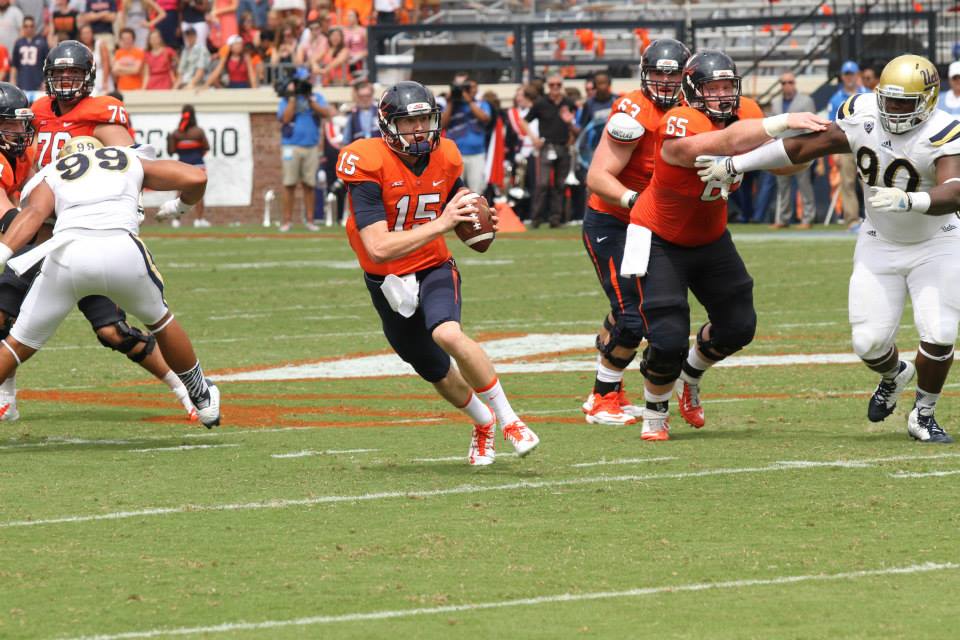
Seeing Matt Johns on the top line was probably a surprise. It shouldn’t have been.
London told reporters that the competition this spring wasn’t close, but honestly, it wasn’t close last fall, either.
Both Lambert and Johns got starts in the fall, and with Lambert in and out of the lineup due to injuries and ineffectiveness, we got a fair comparison of the two over the course of 12 games.
To borrow from London’s characterization of the spring, it wasn’t close.
OK, it was close, cosmetically. Looking at the QB ratings, Johns had a slight advantage (122.57 to 115.74). That’s based entirely on the counting stats, Johns completing 54.9 percent of his passes (89-of-162) for 1,109 yards (6.85 yards per attempt) with eight touchdowns and five interceptions, Lambert completing 59.0 percent of his passes (154-of-261) for 1,632 yards (6.25 yards per attempt) with 10 touchdowns and 11 interceptions.
The slight advantage to Johns becomes more pronounced when looking at the UVA offense over the course of the season on a drive-by-drive basis. Lambert was the quarterback on 97 UVA offensive drives in 2014, and Johns led 57 UVA drives. For the sake of this analysis, which I wrote about back in December, I totaled the numbers from the drive charts and play-by-plays that would also bring in through the dragnet gains and losses associated with penalties, the intent on my part being to give a more accurate representation of game flow than just looking at total offensive yards could give.
That having been established, the Virginia offense produced 150 points on Lambert’s 97 drives (1.55 points per drive), which encompassed 541 total offensive plays (5.58 plays per drive) and gained 2,320 yards of field position (23.92 yards per drive). The UVA offense produced 115 points on Johns’ 57 drives (2.02 points per drive), which encompassed 321 plays (5.63 plays per drive) and gained 1,957 yards of field position (34.33 yards per drive).
It wasn’t close. The UVA offense under Johns scored 30 percent more points and gained 43.5 percent more yards per possession. What’s interesting is that the number of plays per drive was so similar (5.63 plays per drive with Johns at QB, 5.58 plays per drive with Lambert at QB). This is reflective of one last, mind-boggling difference in the data: the gap in average yards per snap.
With Lambert at the helm, Virginia averaged 4.29 yards per play. With Johns, the offense gained 6.10 yards per play.
Over the course of a season of football, Johns grossly outperformed Lambert. The only surprise at the release of the depth chart on Thursday is that London and offensive coordinator Steve Fairchilds are finally conceding the point.
Johns had the offense in a rhythm after he stepped in for Lambert when the opening-day starter went down to injury in the second half of a loss at BYU, leading the Cavs to wins over Kent State and Pitt and putting up solid offensive numbers in a close loss at Duke. But with Lambert declared healthy and ready to go for UNC, Johns was given the clipboard as Virginia limped home to a 1-4 finish marked by sluggish and unproductive offense.
Lambert has an NFL arm, but he has proven to be afraid of using it, opting often for checkdowns that get defenses creeping up as a game wears on because they don’t have to fear him punishing them for cheating up by going over their heads with the deep ball.
Johns may not have the arm that Lambert does, but he is fearless when it comes to trusting his instincts and his receiver corps, which is deep and talented, if underused with Lambert in the backfield.
With Virginia planning to go under center more in 2015, after taking a majority of offensive snaps in 2014 out of shotgun looks, the idea being that going under center will help the running game and create more options for play-action, it is imperative that the quarterback is willing to hit the tight end crossing 15 yards downfield and the wideout streaking down the seam if those throws are there. That opens up the power running game, because the defense has to be cognizant of getting burned downfield; and the more success the running game has against a softened defense, the more the passing game will be able to move the ball through the air.
We saw this work throughout the 1980s and 1990s with George Welsh and Tom O’Brien. It isn’t genius-level football, but it is very effective when it has a quarterback who is a good ball-handler and who is capable of going downfield when that throw is there.
Lambert may one day be that guy, but he isn’t now; Johns, without the pedigree, is, and that’s why he’s the starter coming out of the spring.
– Story by Chris Graham










